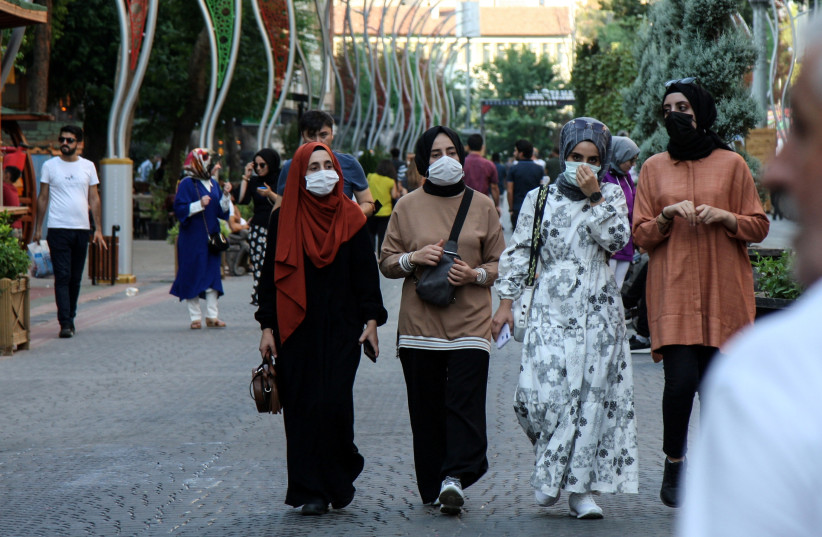coronavirus variant, C.1.2, has been detected in South Africa and a number of other countries, with concerns that it could be more infectious and evade vaccines, according to a
new preprint study by South Africa’s National Institute for Communicable Diseases and the KwaZulu-Natal Research Innovation and Sequencing Platform. The study is awaiting peer review.
Scientists first detected C.1.2 in May 2021, finding that it was descended from C.1, which scientists found surprising as C.1 had last been detected in January. The new variant has “mutated substantially” compared to C.1 and is more mutations away from the original virus detected in Wuhan than any other Variant of Concern (VOC) or Variant of Interest (VOI) detected so far worldwide.
While first detected in South Africa, C.1.2 has since been found in England, China, the Democratic Republic of the Congo, Mauritius, New Zealand, Portugal and Switzerland.
cnxps.cmd.push(function () { cnxps({ playerId: ’36af7c51-0caf-4741-9824-2c941fc6c17b’ }).render(‘4c4d856e0e6f4e3d808bbc1715e132f6’); });
if(window.location.pathname.indexOf(“656089”) != -1){document.getElementsByClassName(“divConnatix”)[0].style.display =”none”;}else if(window.location.pathname.indexOf(“/israel-news/”) != -1){ document.getElementsByClassName(“divConnatix”)[0].style.display =”none”; var script = document.createElement(‘script’); script.src = ‘https://player.anyclip.com/anyclip-widget/lre-widget/prod/v1/src/lre.js’; script.setAttribute(‘pubname’,’jpostcom’); script.setAttribute(‘widgetname’,’0011r00001lcD1i_12258′); document.getElementsByClassName(‘divAnyClip’)[0].appendChild(script);}else if(window.location.pathname.indexOf(“/health-science/”) != -1){ document.getElementsByClassName(“divConnatix”)[0].style.display =”none”; var script = document.createElement(‘script’); script.src = ‘https://player.anyclip.com/anyclip-widget/lre-widget/prod/v1/src/lre.js’; script.setAttribute(‘pubname’,’jpostcom’); script.setAttribute(‘widgetname’,’0011r00001lcD1i_12246′); document.getElementsByClassName(‘divAnyClip’)[0].appendChild(script);}
The scientists believe that the number of available sequences of C.1.2 may be an underrepresentation of the spread and frequency of the variant in South Africa and around the world. The study found consistent increases in the number of C.1.2 genomes in South Africa on a monthly basis, rising from 0.2% of genomes sequenced in May to 1.6% in June and then to 2% in July, similar to the increases seen with the Beta and Delta variants there.
The study also found that the C.1.2 lineage has a mutation rate of about 41.8 mutations per year, which is nearly two times faster than the current global mutation rate of the other variants. The scientists stated that this short period of increased evolution was also seen with the Alpha, Beta and Gamma variants, suggesting that a single event, followed by a spike in cases, drove faster mutation rates.
More than half of the C.1.2 sequences have 14 mutations, but additional mutations have been noticed in some of the sequences, suggesting that evolution within the lineage is ongoing, according to the study.
evade antibodies and immune responses, including in patients who have already been infected with the Alpha or Beta variants.
The scientists added that further work is required to understand the exact impact of these mutations and to see if they give the variant a competitive advantage over the Delta variant.
The study comes as a doctor in Turkey reported indications that a new coronavirus variant had been detected in the country, with tests detecting mutations that weren’t found in the current variants named by the World Health Organization (WHO).
 People wearing protective masks walk along a street amid a surge in COVID-19 cases in Diyarbakir, Turkey (credit: SERTAC KAYAR / REUTERS)
People wearing protective masks walk along a street amid a surge in COVID-19 cases in Diyarbakir, Turkey (credit: SERTAC KAYAR / REUTERS)
Dr. Lütfi Çamlı told Turkish media that while tests were conducted to detect the presence of variants around Turkey, doctors found a new variant with no connection to the other variants, reaching a rate of about 50%-60% of cases in the northern province of Rize. Çamlı stressed, however, that it is still unclear whether they have actually found a new variant or if it was just the result of false negativity in PCR tests.
The doctor additionally stressed that it is normal for new mutations to emerge in an epidemic and that the mutations recently found in Turkey may not have any serious effect on how the virus functions. Çamlı called for further research and for the results of genomic tests of the samples carried out in Ankara to be released to the public.
As of last Wednesday, the WHO had identified four VOCs and four VOIs. As of last Thursday, the European Center for Disease Prevention and Control (ECDC) had identified five and six respectively. A number of other variants have been designated for further monitoring.